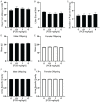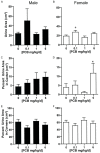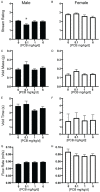Developmental polychlorinated biphenyl (PCB) exposure alters voiding physiology in young adult male and female mice
- PMID: 35528463
- PMCID: PMC9077147
Developmental polychlorinated biphenyl (PCB) exposure alters voiding physiology in young adult male and female mice
Abstract
The impact of developmental exposure to environmental chemicals on lower urinary tract function is not well understood, despite the fact that these chemicals could contribute to etiologically complex lower urinary tract symptoms (LUTS). Polychlorinated biphenyls (PCBs) are environmental toxicants known to be detrimental to the central nervous system, but their impact on voiding function in mouse models is not known. Therefore, we test whether developmental exposure to PCBs is capable of altering voiding physiology in young adult mice. C57Bl/6J female mice received a daily oral dose of the MARBLES PCB mixture for two weeks prior to mating and through gestation and lactation. The mixture mimics the profile of PCBs found in a contemporary population of pregnant women. Voiding function was then tested in young adult offspring using void spot assay, uroflowmetry and anesthetized cystometry. PCB effects were sex and dose dependent. Overall, PCBs led to increases in small size urine spots in both sexes with males producing more drop-like voids and greater peak pressure during a voiding cycle while females displayed decreases in void duration and intervoid interval. Together, these results indicate that developmental exposure to PCBs are capable of altering voiding physiology in young adult mice. Further work to identify the underlying mechanisms driving these changes may help develop more effective preventative or therapeutic strategies for LUTS.
Keywords: Lower urinary tract; bladder; developmental origins of health and disease; persistent organic pollutants.
AJCEU Copyright © 2022.
Conflict of interest statement
None.
Figures






Similar articles
-
Polychlorinated biphenyl (PCB) exposure in adult female mice can influence bladder contractility.Am J Clin Exp Urol. 2023 Oct 15;11(5):367-384. eCollection 2023. Am J Clin Exp Urol. 2023. PMID: 37941647 Free PMC article.
-
Polychlorinated Biphenyls (PCBs) Impact Prostatic Collagen Density and Bladder Volume in Young Adult Mice Exposed during in Utero and Lactational Development.Toxics. 2023 Jul 13;11(7):609. doi: 10.3390/toxics11070609. Toxics. 2023. PMID: 37505574 Free PMC article.
-
In utero and lactational PCB exposure drives anatomic changes in the juvenile mouse bladder.Curr Res Toxicol. 2021;2:1-18. doi: 10.1016/j.crtox.2021.01.002. Epub 2021 Jan 12. Curr Res Toxicol. 2021. PMID: 34337439 Free PMC article.
-
Environmental exposure to polychlorinated biphenyls (PCBs) and dioxins. Consequences for longterm neurological and cognitive development of the child lactation.Adv Exp Med Biol. 2000;478:271-87. Adv Exp Med Biol. 2000. PMID: 11065080 Review.
-
Effects of polychlorinated biphenyls on the nervous system.Toxicol Ind Health. 2000 Sep;16(7-8):305-33. doi: 10.1177/074823370001600708. Toxicol Ind Health. 2000. PMID: 11693948 Review.
Cited by
-
Developmental polychlorinated biphenyl (PCB) exposure impacts on voiding physiology persist into adulthood and influence sensitivity to bladder stimuli in mice.Curr Res Toxicol. 2025 Mar 8;8:100227. doi: 10.1016/j.crtox.2025.100227. eCollection 2025. Curr Res Toxicol. 2025. PMID: 40144452 Free PMC article.
-
Polychlorinated biphenyl (PCB) exposure in adult female mice can influence bladder contractility.Am J Clin Exp Urol. 2023 Oct 15;11(5):367-384. eCollection 2023. Am J Clin Exp Urol. 2023. PMID: 37941647 Free PMC article.
-
Polychlorinated Biphenyls (PCBs) Impact Prostatic Collagen Density and Bladder Volume in Young Adult Mice Exposed during in Utero and Lactational Development.Toxics. 2023 Jul 13;11(7):609. doi: 10.3390/toxics11070609. Toxics. 2023. PMID: 37505574 Free PMC article.
-
Health benefits and health risks of contaminated fish consumption: Current research outputs, research approaches, and perspectives.Heliyon. 2024 Jul 2;10(13):e33905. doi: 10.1016/j.heliyon.2024.e33905. eCollection 2024 Jul 15. Heliyon. 2024. PMID: 39050454 Free PMC article. Review.
-
The aryl hydrocarbon receptor agonist ITE reduces inflammation and urinary dysfunction in a mouse model of autoimmune prostatitis.Am J Clin Exp Urol. 2024 Aug 25;12(4):149-161. doi: 10.62347/PEGK4888. eCollection 2024. Am J Clin Exp Urol. 2024. PMID: 39308590 Free PMC article.
References
-
- Herrick RF. PCBs in school-persistent chemicals, persistent problems. New Solut. 2010;20:115–126. - PubMed
Grants and funding
LinkOut - more resources
Full Text Sources
